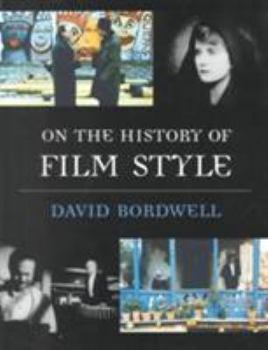On the History of Film Style
Select Format
Select Condition 
Book Overview
The study of cinematic style has profoundly shaped our attitude toward movies. Style assigns films to a tradition, distinguishes a classic, and signals the arrival of a pathbreaking innovation. David Bordwell now shows how film scholars have attempted to explain stylistic continuity and change across the history of cinema. Bordwell scrutinizes the theories of style launched by Andr Bazin, Nol Burch, and other film historians. In the process he celebrates a century of cinema, integrating discussions of film classics such as The Birth of a Nation and Citizen Kane with analyses of more current box-office successes such as Jaws and The Hunt for Red October . Examining the contributions of both noted and neglected directors, he considers the earliest filmmaking, the accomplishments of the silent era, the development of Hollywood, and the strides taken by European and Asian cinema in recent years. On the History of Film Style proposes that stylistic developments often arise from filmmakers' search for engaging and efficient solutions to production problems. Bordwell traces this activity across history through a detailed discussion of cinematic staging. Illustrated with more than 400 frame enlargements, this wide-ranging study provides a new lens for viewing cinema.
Format:Paperback
Language:English
ISBN:0674634292
ISBN13:9780674634299
Release Date:January 1998
Publisher:Harvard University Press
Length:336 Pages
Weight:1.76 lbs.
Dimensions:0.7" x 7.2" x 9.6"
Customer Reviews
2 ratings
Extremely useful book
Published by Thriftbooks.com User , 18 years ago
If you're a student of cinema, you will have great use of this book, written by probably most influential film scholar around; his analysis of the film style are equally rewarding as are his comments on the history of cinema studies. Is Bordwell always right, are his claims without doubt? Hardly. But as students of cinema in many countries know (the book was recently translated into Croatian as well), informed insight is but a beginning of the serious discussion and inspiring analysis...
The way movies really look
Published by Thriftbooks.com User , 24 years ago
Have you ever actually looked at a film? David Bordwell answers the tendency of recent film criticism and analysis to concentrate on the ideological and cultural motivations and manifestations of cinema. His interest is in really looking at the films themselves. Such a 'novel' standpoint has of course a very long tradition, but Bordwell uses the examination of mise-en-scene, framing, focus, control of colour and contrast values to uncover a great deal that is missed in other readings of cinema. Here is a history of film that a practitioner of cinematography (or plain old photography) will appreciate. He does not underestimate or oversimplify the sublety of a filmaker's intentions and gives credit to the ability of the director/cinematographer team to invent and develop a sophisticated visual language. Brodwells commentary is reinforced by 'photograms' (actual frames) selected from a authoratative familiarity with film that is not restricted to American cinema but includes Soviet, Japanese, Indian and European film. It is only the eyestraining size of their (monochrome) reproduction that is disappointing - but then, we can always go and see the films for ourselves!






